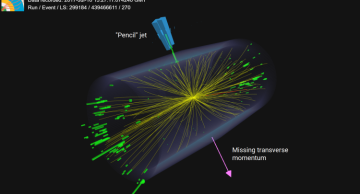For the first time ever, the excited states of three beauty mesons are fully reconstructed and their masses are measured directly, using data from the CMS experiment.
The existence of the excited B meson states, B*+, B*0, and B*0s(also known as…
The CMS Collaboration hunts for Higgs bosons recoiling against dark matter particles
Dark matter is one of the most perplexing mysteries of our universe, accounting for roughly 27% of its total energy. Dark matter does not emit, absorb, or reflect…
The CMS experiment achieves the most precise determination of the strength of the strong nuclear force using the rates of production of jets at several centre-of-mass energies.
The strengths of the fundamental interactions in Nature drive the…
By studying events with only a single energetic photon, the CMS experiment places some of the most stringent constraints to date on dark matter models and theories predicting extra dimensions of space.
One way to explore physics beyond the…
CMS explores the early stages of jet evolution in heavy-ion collisions
When heavy ions such as lead (Pb) collide in the LHC, a new state of matter called the quark-gluon plasma (QGP) is formed. The QGP is a high-temperature near-perfect liquid…
CMS presents the most precise measurement of WWZ production to date by combining Run 2 data with more recent Run 3 data.
The electroweak interaction provides a unified description of the electromagnetic and weak forces, but this symmetry is broken…
The CMS experiment presents the first-ever search for a Higgs boson decaying to charm quarks when the Higgs boson is produced along with two top quarks.
The Higgs boson plays a central role in our understanding of the fundamental forces of…
For the first time, the CMS experiment has employed physics-informed machine learning to observe whether the laws of physics still hold true when top quarks and Z bosons are replaced with their antiparticles and space is reflected.
We know…
An excess in data hints at the existence of a top quark-antiquark quasi-bound state, called “toponium”.
The CMS collaboration has reported an excess in interactions involving top quark pairs. The results are consistent with a pair of top quark and…
The CMS Collaboration investigates whether physics plays favorites with quarks.
In the standard model of particle physics (SM), quarks come in six different types (“flavours”) which are categorized into three generations. Although the standard…
The CMS experiment performs a combined measurement of the scattering of W and Z bosons in the several possible final states, improving over the precision of each individual result.
When the Large Hadron Collider started taking data in 2008,…
The CMS experiment conducts the first search for dark matter particles produced in association with an energetic narrow jet—the pencil jet.
Dark matter remains one of physics’ greatest mysteries. Despite making up about 27% of the universe’s…












